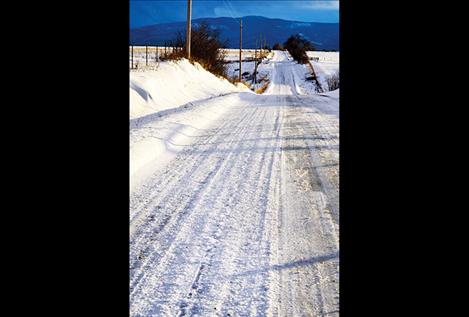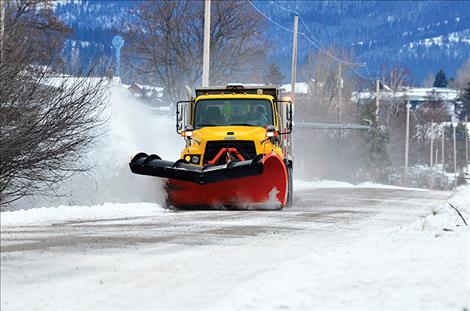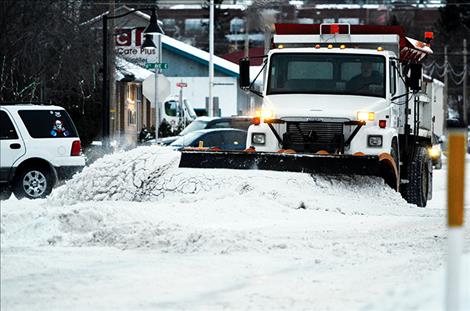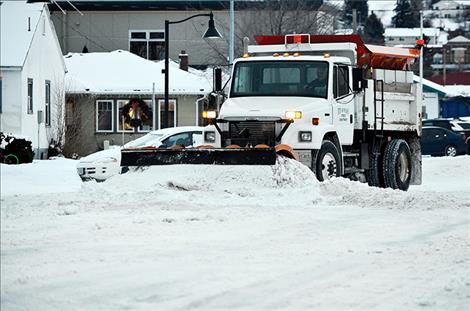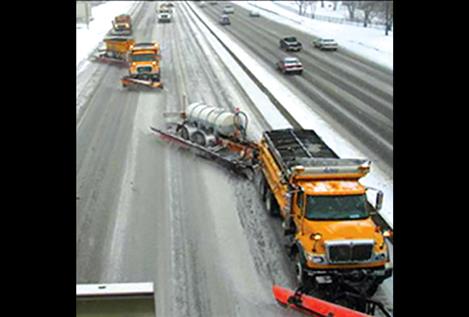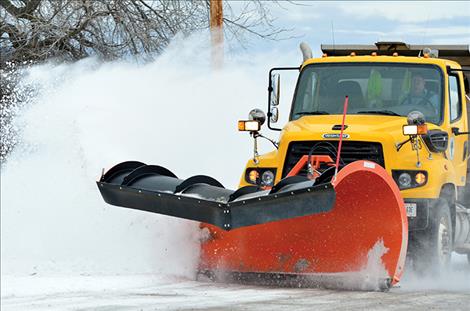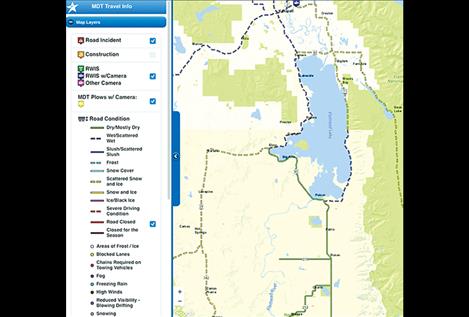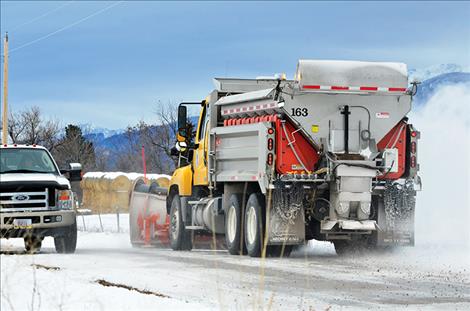Crews work to clear roads
Hey savvy news reader! Thanks for choosing local.
You are now reading
1 of 3 free articles.
LAKE COUNTY – Snowplows across the county are rolling over the roads with their blades down to clear billions of fallen flakes. Three separate departments work different locations to cover the county. The Montana Department of Transportation works to keep the highways clear, the county takes care of what might be called the back roads, and incorporated towns plow their streets.
This year, they’ve all been busy. “We haven’t had this much snow in the last couple of years,” Terry Gembala, street supervisor for Polson, said of heavy snowfall during mid-December.
“When we have three inches of snow, we go out and plow,” he said.
On Christmas Day, the crew was out plowing the roads so people could get around after 8 inches of snow fell.
“On Sunday, we cleared everything,” he said. “It would have been hard for people to get around in that much snow.” The trucks also get taken out when the roads are covered in ice and packed snow.
“We put sand on the intersections when they are slick,” he said.
On Dec. 28, plows in Polson pushed piles of snow down Main Street to clean up the roads. The crew covers streets totaling about 52 miles. It takes a four-person crew about eight hours to cover all the streets. Gembala said they try to get them cleaned up as soon as possible.
He also says it’s a good idea to move off the road when people see the big plow coming down the street.
“It would be much appreciated,” he said. “Please be careful when you see plows until we go by.”
Keeping a distance can also prevent the unfortunate windshield whiteout.
“We don’t want to pelt people with sand and de-icer so please don’t get too close,” he said.
Another good idea is for people to use a different road when they see the plows working to clean the snow. “We are going forward and backward and it makes it easier if we don’t have to worry about cars coming up behind us,” he said.
The Ronan crew starts plowing city roads around 3 a.m. before people are out driving. “We like to get them done early,” Ronan Public Works Director Dan Miller said.
He works on a three-person crew to make sure people can travel over the roads. He said Ronan has slowly upgraded equipment in the past several years and will continue upgrading as needed to help get the job done.
Parking on Main Street isn’t allowed in Ronan during the early morning hours so plowing is made easier. He says the crew works around the cars on other streets.
In St. Ignatius, Public Works Director Scott Morton is part of a one-person crew to clear the roads, although he sometimes has help. It takes him about six hours to finish the work — if the truck starts on time. He also gets up early to plow the roads.
“It’s difficult to plow when people start moving around,” he said.
Morton said the bigger truck he uses to plow the snow wasn’t designed to move between smaller spaces. He said he would be thankful if people wouldn’t park on the roads between 3 a.m. and 8 a.m. on east-to west-running streets and in front of the post office.
“Many people don’t really realize that it’s illegal to park on the roads at that time,” he said.
County plows cover Lake County roads that don’t belong to the state or towns, which includes the back roads and most roads in unincorporated towns.
“We cover 1,200 miles in the county,” Lake County Roads Supervisor Jay Garrick said of his 15-person crew.
Each county crewmember has a regular route they cover, although they move to different areas as needed. They also respond to emergencies, such as the fatal wreck that shut down Highway 93 on Dec. 23. “
We were out plowing and sanding the detour,” he said.
The crew has continued to clean up after the big snowfall around Christmas, clearing roads and putting down sand on snow packed roads. He said the amount of snow that fell is typical for the entire year, although it all came down at one time this year.
“It was a bigger storm than we’ve seen in the last few years,” he said. “We usually don’t get all that much at once so we were very busy moving it.”
The work was made easier this year because voters passed an Equipment Levy in 2015.
“We were fortunate to get the levy,” he said. “Now, eight of our 13 trucks are new.”
In the past, almost half the older trucks would break down.
“They were beyond useful,” he said.
The new equipment reduced the time it takes to cover the county roads.
“What used to take several days to open up, we are now able to do in a single day,” he said. “We can now provide a better level of service.”
The back roads are about 24 feet wide, narrower in some places, and the big trucks are 12 feet wide, which can make it a tight fit for passing cars. Garrick asks that people slow down and give the trucks leeway.
“We are thankful to the citizens of Lake County that help make our jobs easier,” he said.
Mailboxes along the roads create a challenge for the snow plows. He said people have called to report a mailbox being taken out by the plows.
“It’s not intentional,” he said. “Mailboxes need to be strong enough to withstand the snow, and we always try to go around them.”
The Montana Department of Transportation clears about 25,000 lane miles of highway in Montana, including Lake County.
According to MDT, if a snowstorm covers the entire state, the miles required to plow the whole system equates to two times around the earth and it takes them about 24 hours to cover it with about 900 personnel.
The MDT considers air temperature, pavement temperature, humidity levels, precipitation, and weather forecasts before determining how to take care of the roads.
The department uses plows to remove the snow, sand to create traction, and chlorides to a bond to the road, which acts like an anti-freeze. One of the chlorides is in the form of a liquid spray.
“It may seem dangerous to add liquid to a road that might freeze but that liquid can be your best friend when winter driving conditions are at their worst,” according to the MDT.
The liquid helps prevent snow from sticking to the road and black ice from forming. According to the MDT, it’s the newest weapon against bad roads.
It works by lowering the freezing point of moisture on the roads, so travelers should be prepared for wet roads with plenty of windshield wiper fluid. They also recommend, as do county and city departments, that people slow down during winter travel.
For current road conditions, call MDT at 511 or visit their website at mdt. mt.gov.















